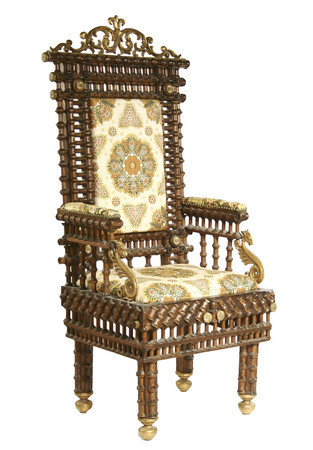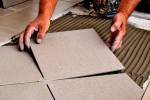Empty thread spools once adorned furniture
Recycling isn't a new idea. Our ancestors reused bits of cloth for quilts, made clothing out of flour bags and used old cigar boxes to make chip-carved picture frames and boxes. Their rule was "waste not, want not," so it's not surprising that the bare wooden spools left after thread was used seemed too practical to ignore.
Sewing machines were introduced to the general public in the 1840s, and a machine needed commercial thread on a spool. A lathe developed about 1815 made turnings that were probably cut apart to use as wooden spools for thread.
Until about 1900, uncut turnings were used to make spool furniture. But another type of spool furniture was made from the empty thread spools that were saved by sewers. A chair or table was constructed of straight pieces of wood, then decorated with dozens of applied spools either left round or cut in half lengthwise. The finished furniture looked like traditional Victorian pieces with elaborate jigsaw decoration.
Today, "sewing spool" furniture is considered folk art. A very large high-back spool chair made about 1900-10 recently sold for $490.
Q: I hope you can settle an argument for us. Was Coors pottery made by the same company that makes Coors beer?
A: Coors pottery was made by Coors Porcelain Co., not the brewery, but there is a connection between the two companies.
John Herold, a German immigrant, founded the Herold China and Pottery Co. in Golden, Colo., in 1910. Herold made oven-safe porcelain dishes at his factory, which was leased from Adolph Coors, founder of the brewery. Coors was a Herold China and Pottery Co. stockholder and board member. John Herold left the company in 1914.
In 1920 the name of the pottery was changed to Coors Porcelain Co. Ovenware and tableware was made until 1980, and custom orders were made after that. The company now makes industrial porcelain under the name CoorsTek.
Q: I have had a 16-inch Morton Salt advertising thermometer for a long time and would like to know what it's worth. It's blue and yellow with a white image of the Morton "Umbrella Girl" and the words "Morton Free Running Salt, When It Rains It Pours." It also says "Never Cakes or Hardens" at the top and "Morton Salt Co., Chicago" at the bottom. The thermometer measures degrees from 40 below 0 to 120 degrees above.
A: Advertising thermometers were popular from the 1920s until the 1970s. They were given to stores that sold the product being advertised.
Morton Salt Co. dates back to 1848, but was incorporated with that name in 1910. The Umbrella Girl was introduced in Morton ads the following year and was first used on boxes of salt in 1914. The girl's image has been updated over the years.
You can buy a new Morton advertising thermometer for $18 on the company's Web site. Old ones sell for more or even less, depending on condition.
Q: I would like to know the difference between hatpins, stickpins and lapel pins.
A: A hatpin is practical as well as decorative, and is used to hold a woman's hat on her head. Hatpins were especially popular during the Victorian era.
A stickpin is a long, straight pin with a decorative head that's worn to hold a necktie or scarf in place. Stickpins became fashionable when men started wearing cravats in the late 18th century. Today, women sometimes wear a stickpin on a collar or lapel as a piece of jewelry.
A lapel pin is usually small and has a short pin on the back. It's meant to be worn on the lapel of a jacket or coat, but may also be pinned onto a hat, dress or collar. A lapel pin may be a badge or company insignia, or it may be just a piece of jewelry. A small American flag is a popular lapel pin today.
Q: I have a vintage Girl Scout mess kit and canteen. They're in mint condition. Would they be of interest to a collector? How much are they worth?
A: Girl Scout collectors search for anything pertaining to the Girl Scouts. The Girl Scout movement started in 1912 under the leadership of Juliette Gordon Low of Savannah, Ga.
Many Girl Scout mess kits were made in the 1950s and '60s. Your kit should have an aluminum fry pan with a swing handle, a cooking pot with a cover, a plate, a plastic cup and stainless steel utensils. All of the pieces fit inside the cooking pot and cover and are held together with a screw handle. The kit originally came in a green plaid carrying case labeled with the Girl Scout insignia. The canteen, with its carrying case, was sold separately.
Vintage Girl Scout mess kits sell for $5 to $10. A mint canteen with its original box can sell for up to $35.
Terry Kovel's column is syndicated by King Features. Write to: Kovels, (Las Vegas Review-Journal), King Features Syndicate, 300 W. 57th St., New York, NY 10019.
























